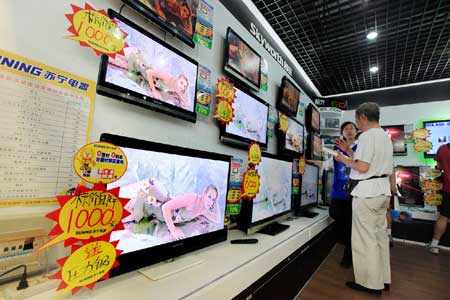BizChina
- Details
- By David Cao
- Hits: 1375
East China's Jiangsu province bought 192,000 tons of cotton from abroad in the first five months of this year, up 280 percent from the same period last year, according to the provincial customs.
The imports were valued at $330 million, up 420 percent, with the average price up 39.1 percent to $1,700 per ton.
Of the total imports, 50.2 percent, or 96,000 tons, were bought from India, up 870 percent.
- Details
- By David Cao
- Hits: 1654

American economists are urging the Chinese government to strengthen efforts to spur domestic consumption in order to help ensure the sustainability of China's economic growth and maintain the balance of trade.
While applauding the efforts China has made in transforming from an export-orientated to a consumption-led economy, academics and senior researchers from the United States said there is still a large gap for the world's most populous nation to fill to bring domestic consumption into full play.
"An increase in consumption is for China's growth, and an increase of consumption helps reduce global imbalances," said Rachel Ziemba, a senior economist on China issues with Roubini Global Economics.
Read more: Economists urge China focus on domestic consumption
- Details
- By David Cao
- Hits: 1479
 ChemChina is one of the top chemicals producers in China but "aims to be among the best in the world," said Ren Jianxin, president of China National Chemical Corp (ChemChina).
ChemChina is one of the top chemicals producers in China but "aims to be among the best in the world," said Ren Jianxin, president of China National Chemical Corp (ChemChina).
This year the company aims to increase its revenue by 22 percent to 139.5 billion yuan in 2010. It also plans to make profits of 3 billion yuan this year, up 173 percent from a year earlier, said Ren.
The company is already doing very well. It ranks second in the world for its production of methionine, and third for its production of organic silicon.
The company is currently expanding its Xinghuo organic silicon project in Jiangxi province, which is expected to be the world's largest production facility of the material.
Humble beginnings
Today ChemChina ranks 28th in China's top 500 enterprises, and it is 19th in the world's 100 leading chemical companies.
The company was started 26 years ago with loans of only 10,000 yuan. In 1984 Ren founded Bluestar Co to start his industrial cleaning business. Several years later Bluestar dominated China's industrial cleaning industry. In 1995 the company moved its headquarters from Lanzhou to Beijing, and one subsidiary, Bluestar Cleaning, was listed on the Shanghai Stock Exchange.
Since that year Ren began to eye other businesses and in 1996 Bluestar merge with Xinghuo Chemical Co, a manufacturer of organic silicon. Following the purchase of Xinghuo, Bluestar made many other acquisitions on the domestic market and by 2002 the company's total assets increased to 4 billion yuan.
In 2004 Bluestar, together with China Haohua Chemical (Group) Corporation, and some other chemical companies formed ChemChina, the biggest chemical producer in the country.
"We are now focusing on the development of new materials and specialty chemical products," said Ren. "Improvement in technology will play a vital role in achieving this target."
Overseas expansion
ChemChina has made a series of overseas acquisitions in the past few years. In 2006 the company acquired French company Adisseo, a firm specializing in producing methionine, vitamins and biological enzymes. In the same year ChemChina bought another French company Rhodia's organic silicon business.
After the acquisitions the company boosted its production of methionine to number two in the world and organic silicon production to the top three.
In 2007 ChemChina signed an agreement with US private equity Blackstone Group, under which the US company will invest up to $600 million in ChemChina's subsidiary Bluestar for a 20 percent stake.
These acquisitions not only boosted some of ChemChina's business into those with global competency, but also improved the company's technologies a lot, said Ren.
With the acquisitions ChemChina has got many patents with its own intellectual property (IP). The company now ranks among the best in terms of numbers of IP among enterprises owned by China's central government.
- Details
- By David Cao
- Hits: 1581
South Australia's (SA) world- renowned wineries on Wednesday said they hope to tap into China's burgeoning wine market with a trade mission and wine tastings.
Twelve wineries, including Belvidere, Chalk Hill and Bethany, spanning every wine growing region in the state are being represented on a mission to China, SA Minister for Industry and Trade Tom Koutsantonis said.
"The rapidly expanding Chinese middle class is creating outstanding opportunities for South Australian wine," the minister said in a statement.
Read more: South Australian wineries interested in China wine market
- Details
- By David Cao
- Hits: 1295
services companies, the new great frontier is China. Obviously the question at the forefront of everyone’s mind is how to expand into this region without having your proprietary technology pirated by this region’s upstart competitors. The reality is there is no safe way. I’m sure that’s not what the reader wants to hear but the reality is whenever you are bringing a technology concept to a newly industrialized territory you’ll run into corruption, the way to enter this market is to set up safeguards and strategies to protect the integrity of the technology and any other proprietary concepts.
For those looking to have their products manufactured in China this can save a fortune if it’s done properly. You should look at the construction of your product in this area as if you were dealing with a DOD project. Have different aspects of your devise manufactured at different locations without issuing information about the identity of the end product. This seems to work extremely well.
Read more: How To Expand Into China And Asia: An Insider’s Guide For Massive Expansion Fast
More Articles …
Page 58 of 120